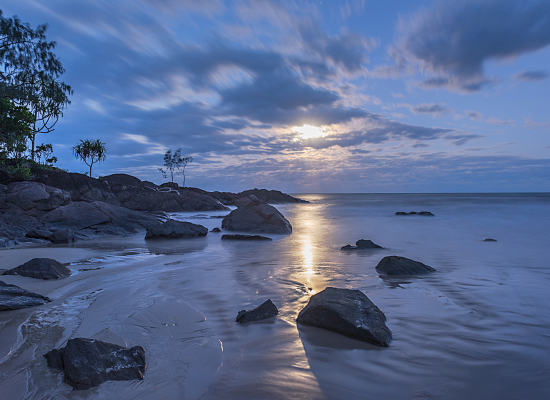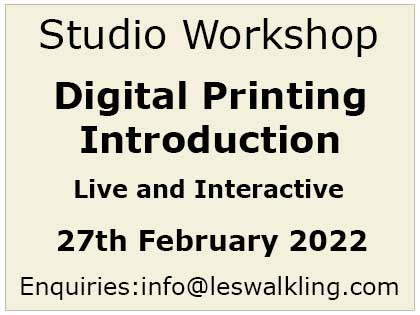 Les Walkling, Moonrise Daintree 2017, inkjet pigment print, 800 x 1100 mm
Les Walkling, Moonrise Daintree 2017, inkjet pigment print, 800 x 1100 mm
Education entertains nearly a third of my professional life. Therefore why I teach, and why I teach in far away places like ‘the Daintree’ are important personal, artistic and pedagogical questions.
The answer, in part, is that ‘the Daintree’ doesn’t have Icelandic waterfalls, nor Patagonian peaks, nor Antarctic ice flows, nor other easily accessed spectacular spectacles. Though far away it is not a photographic safari. The Daintree is also downright hard to photograph. In other words, being without typical magnificent photographic ‘distractions’, it can therefore be an exercise in distancing ourselves from distractions, including those of our everyday lives, in order to concentrate on ‘being an artist’ and what that might mean in the 21st century. In short, the Daintree is an art-school where we can momentarily be out of the ‘line of fire’ and without prejudice work on our aptitude and priorities before returning to the ‘heat of the moment’.
There is also the answer that ‘the Daintree’ is rare, ancient, World Heritage listed, ecologically-sensitive, and hard to make sense of. The site of the workshop, the James Cook University Daintree Rainforest Observatory (DRO) and its dormitory accommodation, is also not about exclusiveness or privilege, but about coming together, belonging, and community building. The Daintree and DRO therefore take us out of our everyday commonsense, our expectations and comfort zone, and remembers that to share something is to more than double its worth. It is about what it means to indulge in things that matter the most to us, such as our creativity, and the responsibility we have to share knowledge, skills and thinking as a way of acting on our feelings and questioning our beliefs.
There is also the problem that formal photographic education all too often appears to prescribe staged outcomes that threaten the imaginative and the speculative, and in turn normalize these definitions and attitudes. Prescriptive teaching and learning outcomes can’t reward imagination because imagination (and creativity, innovation etc.) can’t be so easily judged or measured. Predefined outcomes, while perfectly fine in regulated industries – after all I would like my doctor to know certain things about medicine – end up discouraging the very thing that an arts education can foster, where personal objectives, shared outcomes, and speculative adventures are not only possible, but desired.
Our Daintree workshop is designed to counter these tendencies and the sad corollary that photography often means being expertly ignorant about what you are doing, or perhaps even worse, being incredibly ‘experienced at doing the wrong thing’. This leads to pronouncements ranging from simply stupid to down right misleading, if not fraudulent. An art-school therefore saves you some time, as well as many of the bruises (physical, emotional and creative) that can accumulate when you try to do this on your own. And while ‘how we interpret an image’ is as individual as we are and demands respect, how pictures push and pull on us is more reliable and can be learned, and worked with.
Therefore coming together in a far away place, and our relationship with photography, and photographic history and our contribution to it, is an act of defiance in the face of the multiple ahistorical instantaneous ‘nows’ dominating the vastness of today, and it seems, much of our contemporary consciousness, let alone photographic education.


{ 1 comment… read it below or add one }
My friend Michael Smyth sent me this article on photo education as he knew I would relate to it. Thank you for this delightful summation. It offers, for me, really important principles about creativity in photography and how it might be developed. Much of the traditional approaches centred on convergence and prescription – particularly within community arts – seem intent on blinding people. Your article is a breath of fresh air to this reader.
Cheers
{ 2 trackbacks }